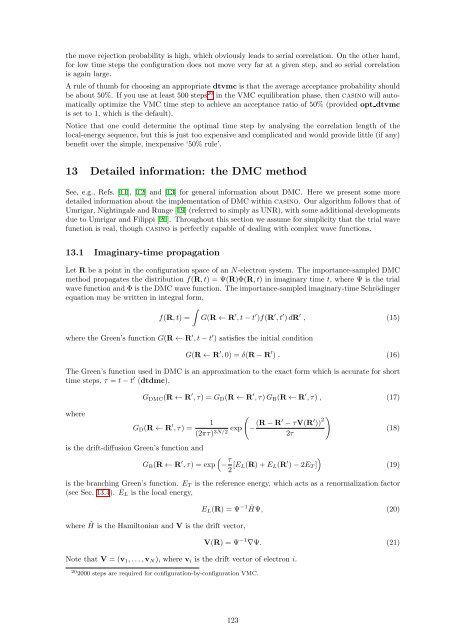CASINO manual - Theory of Condensed Matter
CASINO manual - Theory of Condensed Matter
CASINO manual - Theory of Condensed Matter
Create successful ePaper yourself
Turn your PDF publications into a flip-book with our unique Google optimized e-Paper software.
the move rejection probability is high, which obviously leads to serial correlation. On the other hand,<br />
for low time steps the configuration does not move very far at a given step, and so serial correlation<br />
is again large.<br />
A rule <strong>of</strong> thumb for choosing an appropriate dtvmc is that the average acceptance probability should<br />
be about 50%. If you use at least 500 steps 20 in the VMC equilibration phase, then casino will automatically<br />
optimize the VMC time step to achieve an acceptance ratio <strong>of</strong> 50% (provided opt dtvmc<br />
is set to 1, which is the default).<br />
Notice that one could determine the optimal time step by analysing the correlation length <strong>of</strong> the<br />
local-energy sequence, but this is just too expensive and complicated and would provide little (if any)<br />
benefit over the simple, inexpensive ‘50% rule’.<br />
13 Detailed information: the DMC method<br />
See, e.g., Refs. [11], [12] and [13] for general information about DMC. Here we present some more<br />
detailed information about the implementation <strong>of</strong> DMC within casino. Our algorithm follows that <strong>of</strong><br />
Umrigar, Nightingale and Runge [19] (referred to simply as UNR), with some additional developments<br />
due to Umrigar and Filippi [26]. Throughout this section we assume for simplicity that the trial wave<br />
function is real, though casino is perfectly capable <strong>of</strong> dealing with complex wave functions.<br />
13.1 Imaginary-time propagation<br />
Let R be a point in the configuration space <strong>of</strong> an N-electron system. The importance-sampled DMC<br />
method propagates the distribution f(R, t) = Ψ(R)Φ(R, t) in imaginary time t, where Ψ is the trial<br />
wave function and Φ is the DMC wave function. The importance-sampled imaginary-time Schrödinger<br />
equation may be written in integral form,<br />
∫<br />
f(R, t) = G(R ← R ′ , t − t ′ )f(R ′ , t ′ ) dR ′ , (15)<br />
where the Green’s function G(R ← R ′ , t − t ′ ) satisfies the initial condition<br />
G(R ← R ′ , 0) = δ(R − R ′ ) . (16)<br />
The Green’s function used in DMC is an approximation to the exact form which is accurate for short<br />
time steps, τ = t − t ′ (dtdmc),<br />
G DMC (R ← R ′ , τ) = G D (R ← R ′ , τ) G B (R ← R ′ , τ) , (17)<br />
where<br />
G D (R ← R ′ , τ) =<br />
(<br />
)<br />
1<br />
(2πτ) exp − (R − R′ − τV(R ′ )) 2<br />
3N/2 2τ<br />
(18)<br />
is the drift-diffusion Green’s function and<br />
G B (R ← R ′ , τ) = exp<br />
(<br />
− τ )<br />
2 [E L(R) + E L (R ′ ) − 2E T ]<br />
(19)<br />
is the branching Green’s function. E T is the reference energy, which acts as a renormalization factor<br />
(see Sec. 13.4). E L is the local energy,<br />
where Ĥ is the Hamiltonian and V is the drift vector,<br />
Note that V = (v 1 , . . . , v N ), where v i is the drift vector <strong>of</strong> electron i.<br />
20 2000 steps are required for configuration-by-configuration VMC.<br />
E L (R) = Ψ −1 ĤΨ, (20)<br />
V(R) = Ψ −1 ∇Ψ. (21)<br />
123

















